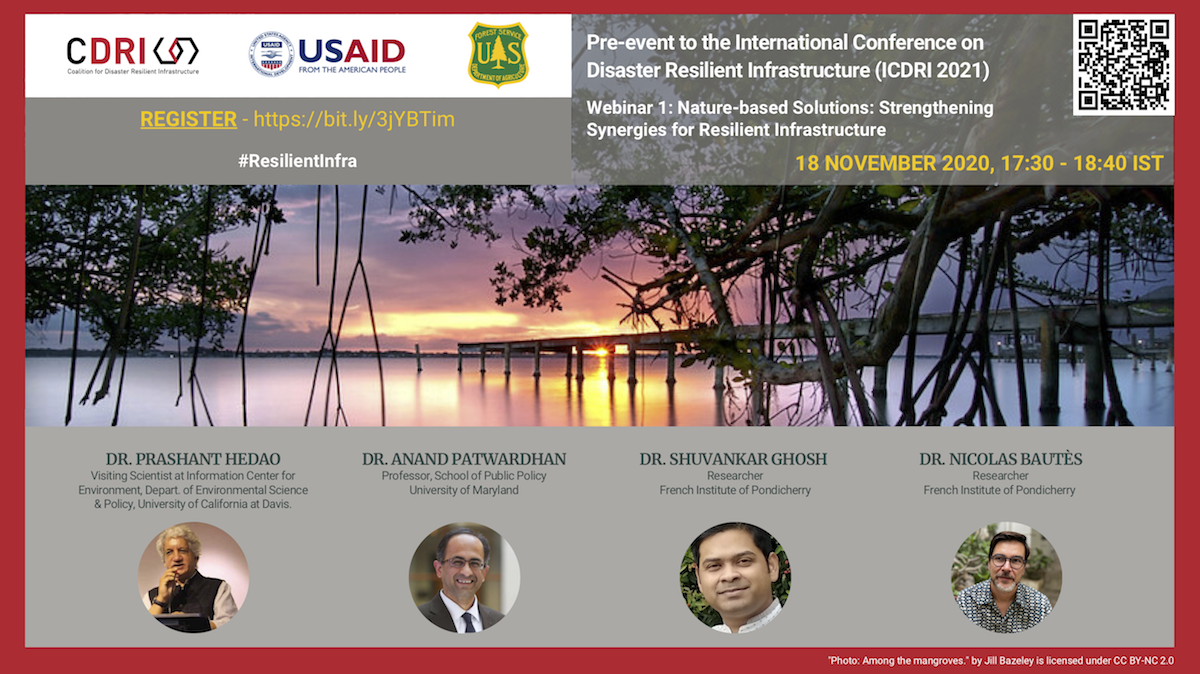- +91-11-4044-5999
- info@cdri.world
-
Copernicus Marg, New Delhi, INDIA

NEW DELHI, 19 November 2020 – The force of nature can form a powerful wall of defence to protect lives, livelihoods and even massive infrastructure that services rural communities and major cities alike. This is the take-away message from a webinar of experts organized on 18 November by the Coalition for Disaster Resilient Infrastructure (CDRI) in partnership with the U.S. Agency for International Development (USAID) and the U.S. Forest Service International Programs (USFS-IP).
The webinar was the first of a series to inform discussions at the third International Conference on Disaster Resilient Infrastructure (ICDRI 2021), to be held from 17 to 19 March 2021. ICDRI 2021 will deliberate on international commitments that are significant for building disaster and climate resilient infrastructure
“We continue to learn more about how nature-based solutions, such as mangroves and wetlands, act as barriers against storm surges and other hazards which threaten people and the roads, hospitals and homes that we all rely on every day,” said Mr. Kamal Kishore, Indian Co-Chair of CDRI Executive Committee and Member, National Disaster Management Authority. “Resilient infrastructure is not just a concern for engineers and scientists. It protects and affects all of us.”
Nature-based solutions for disaster risk reduction include restoring mangroves along coastlines to reduce the impact of waves and storm surge on the shoreline to prevent flooding and preserving wetlands, forests and floodplains
“The very complexity of ecological, political and social changes across coastal space cannot be understood in silos. They therefore need a transversal approach, in which people living in and from the coast need to be considered in their interaction with nature and infrastructure,” said panelist Dr. Nicolas Bautes to introduce the multidisciplinary project FisherCoast. Along with his colleague at the French Institute of Pondicherry, Dr. Shuvankar Ghosh, he studies changes in the Pichavaram mangroves in Tamil Nadu, India. “When assessing the severity of environmental threats and efficacy of restoration measures, we must ask ourselves if we should let nature take its course and restore itself, or do we help it along by planting additional mangroves. It sounds simple, but the verdict is still out.”
With increasing environmental degradation some natural disaster safeguards are deteriorating, resulting in an increased risk of infrastructure failure. Panelists stressed the urgency of adopting a nature-based approach that promotes infrastructure development and protects and uses these natural safeguards which act as disaster buffers to protect people and infrastructure.
“Through partnerships, governments, donors, the private sector and community leaders must work together to promote nature-based solutions to shore up resilient bridges, schools and other infrastructure,” said Ms. Karen Klimowski, Acting Mission Director of the United States Agency for International Development (USAID) in India. “If we engage with nature along coastlines and mountain ravines, we will boost our defences in disaster-prone areas for the benefit of all.”
Policy can play a significant role in advancing nature-based solutions, according to Dr. Anand Patwardhan, a professor at the University of Maryland. “Policies can help convert the favorable economics of nature-based solutions into financing models that can lead to deployment at scale,” he said. “Leveraging nature for resilience can help in ensuring the resilience of nature.”.
Leading up to ICDRI 2021, the webinar series is being designed around themes that draw synergies with international commitments such as Sustainable Development Goals (SDGs) and Sendai Framework for Disaster Risk Reduction (SFDRR). Nature-based solutions are essential components of the overall global effort to achieve the targets and goals of the SDGs and SFDRR on climate change.
For related images, visit our Flickr page: https://www.flickr.com/photos/190504301@N07/albums/72157716828259827
For more information Visit the CDRI website (www.cdri.world) and follow CDRI on Twitter (@CDRI_world) and LinkedIn (@coalition-for-disaster-resilient-infrastructure) to receive the latest updates on CDRI's activities.